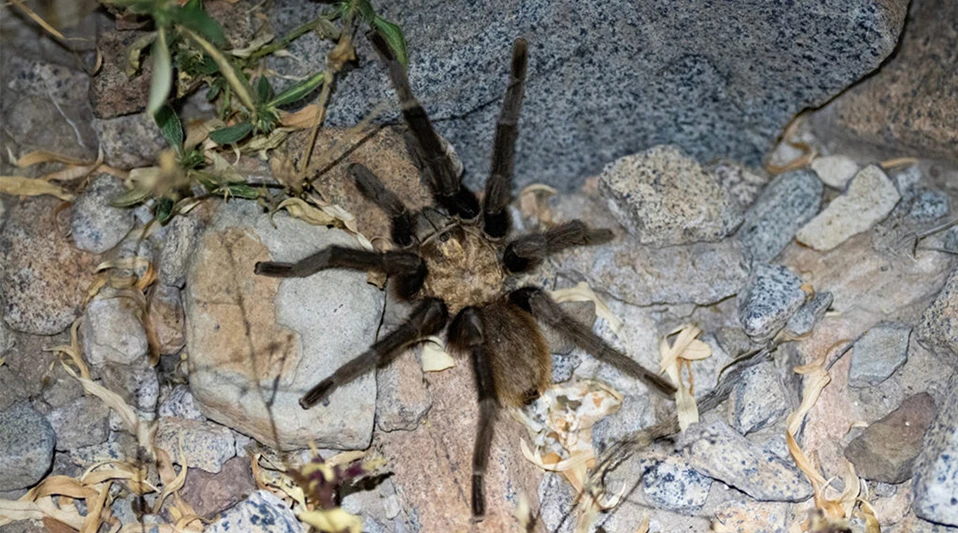
Credit Sam Craft/Texas A&M AgriLife
If you see tarantulas moving in greater numbers around Texas, don’t fear...they’re just looking for love.
Some folks equate this annual movement of these large, fuzzy arthropods to seasonal migration. But Wizzie Brown, Texas A&M AgriLife Extension Service entomology specialist in the Texas A&M Department of Entomology, Travis County, said the mass movement of tarantulas between May and August is not a true migratory event.
The uptick in tarantula activity and movement can be attributed to males searching for females to mate, Brown said, adding that the timing of their emergence and subsequent mating season is triggered by warmer spring temperatures and moisture. This means their location across the state can be a determining factor for emergence and activity.
“This spring has been warmer, so it may begin a little earlier than normal,” Brown said. “Usually once it warms up and we get some decent rain you will begin to see them. If you think about it, those same conditions mean more insects are emerging, which means more food for tarantulas’ offspring at that point.”
Despite their size, tarantulas shouldn’t be feared by humans, Brown said. If encountered, she recommended just admiring them and leaving them be.
Tarantulas are not venomous to humans, but they can bite. They will typically give warnings by rearing up on their hind legs to look bigger or showing their fangs before they bite. Brown equates the bite to a bee sting.
They will also kick hairs off their abdomen as a defensive mechanism, she said. The hairs are prickly like a cactus with fine spines. Some people develop rashes from the hairs.
“They can be scary when judged by their size and looks,” she said. “They’re large, but they’re no danger to us. They can be grumpy when handled roughly, but if they bite, it’s typically from being provoked. So, look at them and appreciate them because they are beneficial. But people shouldn’t handle tarantulas in the wild.”
Tarantulas are found on every continent in the world except Antarctica. They are the largest spiders on Earth, and Brown said species native to Texas can reach up to 6 inches from the tip of their front legs to the tip of their back legs.
Tarantulas are arthropods, which means they have an exoskeleton they molt numerous times throughout their lives. They have eyes, two distinct body regions, eight legs and are covered in hair. Texas tarantulas are typically blackish-to-brownish in color, and darker after they molt.
There are 15 tarantula species across Texas, so they are not an uncommon sight during the annual mating season, Brown said. But they are more common and noticeable in certain areas and terrain.
“The likelihood of an encounter is higher in some parts of the state like rockier areas of Central and Southwest Texas, but you can find them east of Interstate 35,” Brown said. “Some of that is simply related to populations, but it can also be how they stand out in some habitats compared to others.”
Texas tarantulas prefer to burrow in the soil. They do not use webs to capture prey, but rather to line their burrows to prevent collapse, and as a mat for the molting process, Brown said. Females lay 100 to 1,000 eggs in a web constructed like a hammock.
Female tarantulas have lived up to 25 years in captivity, while males live around two to three years in the wild or five to 10 years in captivity once they mature.
Tarantulas may be big and look scary, but they are not aggressive or venomous. However, handling wild tarantulas can lead to a bite akin to a bee sting.
Tarantulas are nocturnal predators. Rather than using webs to capture prey, Brown said they rely on ambush to hunt, and feed on insects, other spiders and small lizards, frogs and snakes.
They remain in or around their burrow where they have webbed trip lines that help them “feel” the vibration of approaching prey, she said.
When prey is captured, it is then bitten with the spider’s fangs and injected with venom that has digestive enzymes that kills and liquefies it. Once the prey is soupy, the tarantula sucks up juices through its fangs. While tarantulas are capable of biting humans, their venom does not react with our body chemistry like black widow or recluse spiders.
Brown said door seals are typically enough to exclude tarantulas from homes because of their size. But in the case of an in-home encounter, she suggested covering it with a glass and sliding paper underneath the spider to move it.
“Tarantulas aren’t aggressive, and they’re not jumpers, so people shouldn’t worry about them,” she said. “But I can also understand people viewing them as a pest if they are finding them in the house.”
Brown added, “The thing to remember is they’re shy and docile unless provoked, and a benefit because they eat pest insects. And this time of year, tarantulas are just hunting for food and a mate.”
Source: Texas A&M AgriLife Extension Service
WANT MORE?
Enter your email to receive our newsletters.
Latest from Pest Control Technology
- How to Get Rid of Odorous House Ants
- Massey Services Promotes Herndon to Director of Sales for Multi-Family Division
- NPMA Announces First Recipients of NPMA PRO Certified Credential
- Pestmaster of the Hudson Valley Acquires Catskill Animal Damage Control
- Photo Slideshow: Ant Identification Tips
- Video: Top 10 PCT Photo Contest Finalists
- UF/IFAS Study Reveals Boats as Perfect Vessels for Global Termite Spread
- Pest Control Consultants (Iowa) Earns Pinnacle Performance Award





